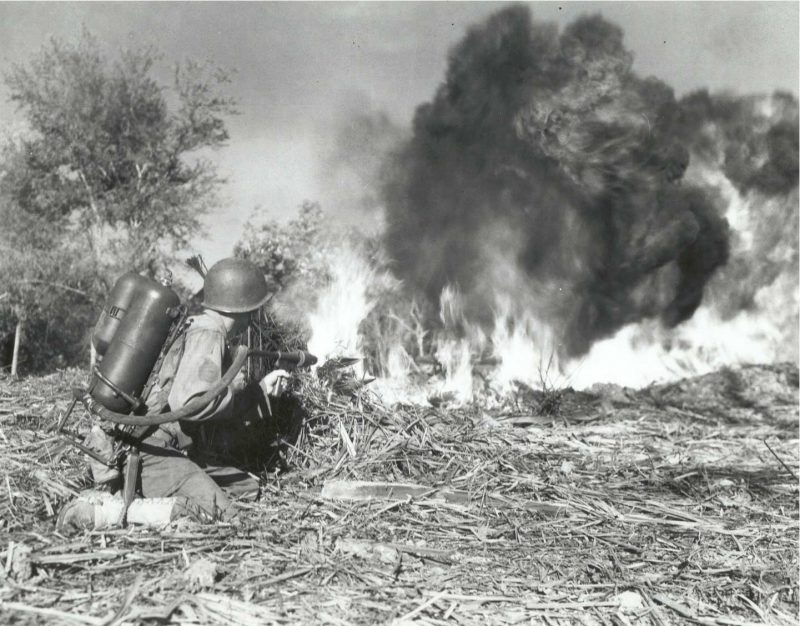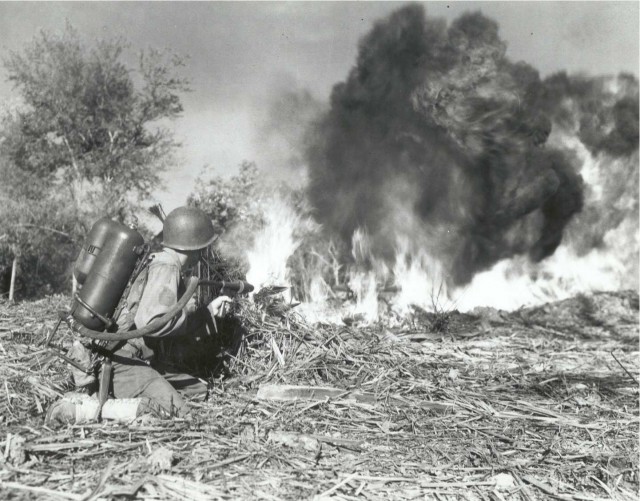There aren’t many weapons that put fear and horror into every man more than the flamethrower.
Flamethrower, flammenwerfer, lanciafiamme, whatever it’s called, it conjures up horrific images of the victims of the most brutal and barbaric weapon on the battlefield. Charred bodies, half out of foxholes or pillboxes, teeth grinning a defiant smile even in death; one can only imagine the stench and smell that such a weapon creates. Screams of the unfortunate so high pitched as to be almost inhuman. The mere sight and sound of this weapon caused havoc to the inflicted. Bullets and bombs, just as deadly and horrific, cannot be seen to be so. Although deadlier than the one-man inferno, the effect on the mind is different and to a veteran of, say, the trenches; is ‘part of a soldiers lot’. Jets of flame, however, arching high into the air and igniting all they engulf can’t be reasoned with. No wounds here or close escape burnt limbs; eyelids stuck to the faces of those too slow to have moved and every piece of flesh, exposed or otherwise turned to a mass of darkened charcoal.
As the book explains the mental effect that flames had on soldiers, especially those that were dug in, far out way the actual success of such a weapon. With bursts of flames ranging from a mere one second to just under a minute the actual rate of a single weapon is pretty much negligible compared to s a light machine gun or even a mortar. What the book explains, though, is the impact on the mind. It touches the most primeval of all fears; being burnt alive.
Flames in warfare have been around since day one. Harnessing such power is a different subject altogether. Accounts of liquid fire go back to biblical times. The ancient Greeks used such weapons on the battlefield in the 4th Century BC, however it really only became widely used in the middle ages. The sight of flame on the battlefield must have been as frightening then as it is now but advancements were constantly made to try and improve this portable hell.
That said, the first real flamethrower as we know it was an improvement and soon to be established German affair during the early part of the 20th Century. It would appear that the other major powers; Britain included, weren’t as impressed with this weapon making a comeback and were always a close second in both thought and design. After some initial uses of flame on French troops in 1914 the first real attack of note by the Germans during WW1 was an assault at the infamous Hooge site just outside Ypres in Belgium. Standing at the site today one can really sense the claustrophobic feel such an attack had on the British. After a period of just two days fighting the allies lost nearly 800 men, many to the Germans flame. The attack horrified the British high command and the future of the weapon was set.
‘Fight fire with fire’ was to be the cry.
By the end of WW1 every country had either made or designed its own flamethrower. The stage was set and this irreversible weapon was back to stay.
Used extensively throughout WW2 by the British, Americans and Germans in almost equal numbers it was as much a part of the battlefield as a tank or artillery .The Germans fight with the Russians on the Eastern Front was immortalised by images of SS troops burning villages and towns. Likewise for the Americans the flamethrower came and went hand in hand with the battles in the Pacific. The Japanese feared and loathed it as the flamethrower caused havoc and created hell in a place that seemed perfectly suited for such a horrendous tool.
By the end of WW2 the weapon had enjoyed its finest hours but refused to burn out totally. Condemned by many, it continued to be used in the conflict in Vietnam and later Cambodia. Even at the turn of the 21st Century it was still in many countries arsenals.
It is still in use today, and although limited time and thought is given to such a weapon it has been seen in many recent conflicts. How has such a weapon remained on the frontline? Simple. It has fear factor. As long as man has a fear of fire the flamethrower will be lurking in the shadows like an unwanted guest at a dinner party. Will it ever be totally removed? Probably….. when hell freezes over.
Reviewed by Phil Hodges for War History Online

THE FLAMETHROWER
By Chris McNab
Osprey Publishing
ISBN 978-1-4728-0902-5

